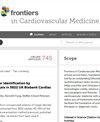First manifestation of cardiovascular disease according to age and sex in a Mediterranean country
IF 2.8
3区 医学
Q2 CARDIAC & CARDIOVASCULAR SYSTEMS
引用次数: 0
Abstract
BackgroundCardiovascular (CV) diseases are the most common cause of death worldwide. This study aimed to investigate the incidence and type of first CV event in a broad cohort of Spaniards, focusing on age and sex differences.MethodsThis was a retrospective study using the SIDIAP database. Subjects aged 30–89 years in 2010 were included. Individuals with prevalent CV disease or atrial fibrillation were excluded. Subjects were followed until the occurrence of a CV event, death, or the study end (December 2016). CV outcomes (coronary heart disease [CHD], cerebrovascular or peripheral artery disease and heart failure [HF]) during follow-up were analyzed. Clinical, anthropometrical, and laboratory data were retrieved from clinical records.ResultsOverall, 3,769,563 at-risk individuals (51.2 ± 15.2 years) were followed for a median of 7 years. The cumulative incidence of a first CV event was 6.66% (men vs. women, 7.48% vs. 5.90%), with the highest incidence (25.97%) among individuals >75 years. HF (29%) and CHD (28.8%) were the most common first events overall; in men it was CHD (33.6%), while in women it was HF and cerebrovascular disease (37.4% and 27.4%). In younger age groups, CHD was more prevalent, with HF in older age groups. Baseline CV risks factors conferred more risk in younger ages and differed between men and women.ConclusionsThe incidence and type of the first CV event in this Mediterranean region were significantly influenced by age and sex. This information is relevant for tailoring primary prevention strategies including the treatment of risk factors.地中海国家按年龄和性别划分的心血管疾病首发症状
背景心血管疾病是全球最常见的死亡原因。本研究旨在调查一大批西班牙人中首次心血管疾病的发病率和类型,重点关注年龄和性别差异。研究纳入了 2010 年年龄在 30-89 岁之间的受试者。不包括患有心血管疾病或心房颤动的人。对受试者进行随访,直至发生心血管事件、死亡或研究结束(2016 年 12 月)。分析了随访期间的心血管疾病结果(冠心病 [CHD]、脑血管或外周动脉疾病和心力衰竭 [HF])。结果总计对 3,769,563 名高危人群(51.2 ± 15.2 岁)进行了中位数为 7 年的随访。首次心血管事件的累积发生率为 6.66%(男性与女性相比,7.48% 与 5.90%),其中年龄在 75 岁以上者的发生率最高(25.97%)。高血压(29%)和冠心病(28.8%)是最常见的首发疾病;男性为冠心病(33.6%),女性为高血压和脑血管疾病(37.4% 和 27.4%)。在较年轻的年龄组中,冠心病的发病率较高,而在较年长的年龄组中,心房颤动的发病率较高。结论 在地中海地区,首次心血管事件的发生率和类型受年龄和性别的显著影响。这些信息对于制定包括治疗风险因素在内的初级预防策略具有重要意义。
本文章由计算机程序翻译,如有差异,请以英文原文为准。
求助全文
约1分钟内获得全文
求助全文
来源期刊

Frontiers in Cardiovascular Medicine
Medicine-Cardiology and Cardiovascular Medicine
CiteScore
3.80
自引率
11.10%
发文量
3529
审稿时长
14 weeks
期刊介绍:
Frontiers? Which frontiers? Where exactly are the frontiers of cardiovascular medicine? And who should be defining these frontiers?
At Frontiers in Cardiovascular Medicine we believe it is worth being curious to foresee and explore beyond the current frontiers. In other words, we would like, through the articles published by our community journal Frontiers in Cardiovascular Medicine, to anticipate the future of cardiovascular medicine, and thus better prevent cardiovascular disorders and improve therapeutic options and outcomes of our patients.
 求助内容:
求助内容: 应助结果提醒方式:
应助结果提醒方式:


